Optimizing an Inner-Continental Shelf Geologic Framework Investigation through Data Repurposing and Machine Learning
Abstract
1. Introduction
2. Geologic Setting
3. Methods
3.1. Data Sources
3.2. Image Analysis Approach and Testing
3.3. Accuracy Evaluation
3.4. Applying Classification to the Entire Dataset
4. Results
4.1. Mapped Accuracy
4.2. Classified Maps
5. Discussion
6. Conclusions
Author Contributions
Funding
Acknowledgments
Conflicts of Interest
References
- Johnson, S.Y.; Cochrane, G.R.; Golden, N.E.; Dartnell, P.; Hartwell, S.R.; Cochran, S.A.; Watt, J.T. The California seafloor and coastal mapping program—Providing science and geospatial data for California’s State Waters. Ocean Coastal Manag. 2017, 140, 88–104. [Google Scholar] [CrossRef]
- United States Geological Survey. Geologic Mapping of the Massachusetts Sea Floor. Available online: https://woodshole.er.usgs.gov/project-pages/coastal_mass/index.html (accessed on 14 March 2019).
- National Oceanic and Atmospheric Administration. Survey H11554—Multibeam and Side Scan Sonar Descriptive Report: National Oceanic and Atmospheric Administration SAIC Doc.; 06–TR–015; National Oceanic and Atmospheric Administration: Silver Spring, MD, USA, 2016; p. 29. Available online: https://data.ngdc.noaa.gov/platforms/ocean/nos/coast/H10001-H12000/H11554/DR/H11554.pdf (accessed on 14 March 2019).
- National Oceanic and Atmospheric Administration. Survey H11555—Multibeam and Side Scan Sonar Descriptive Report: National Oceanic and Atmospheric Administration SAIC Doc.; 06–TR–0; National Oceanic and Atmospheric Administration: Silver Spring, MD, USA, 2016; p. 86. Available online: https://data.ngdc.noaa.gov/platforms/ocean/nos/coast/H10001-H12000/H11555/DR/H11555.pdf (accessed on 14 March 2019).
- National Oceanic and Atmospheric Administration. Survey H11650—Multibeam and Side Scan Sonar Descriptive Report: National Oceanic and Atmospheric Administration SAIC Doc.; 07–TR–011; National Oceanic and Atmospheric Administration: Silver Spring, MD, USA, 2017; p. 40. Available online: https://data.ngdc.noaa.gov/platforms/ocean/nos/coast/H10001-H12000/H11650/DR/H11650.pdf (accessed on 14 March 2019).
- National Oceanic and Atmospheric Administration. Survey H11647—Multibeam and Side Scan sonar descriptive report: National Oceanic and Atmospheric Administration SAIC Doc.; 07–TR–008; National Oceanic and Atmospheric Administration: Silver Spring, MD, USA, 2007; p. 35. Available online: https://data.ngdc.noaa.gov/platforms/ocean/nos/DAPRs/OPR-D302-KR-307.pdf (accessed on 14 March 2019).
- National Oceanic and Atmospheric Administration. Survey H11648—Multibeam and Side Scan Sonar Data Acquistion & Processing Report; OPR–D302–KR–07; National Oceanic and Atmospheric Administration: Silver Spring, MD, USA, 2007; p. 35. Available online: https://data.ngdc.noaa.gov/platforms/ocean/nos/DAPRs/OPR-D302-KR-307.pdf (accessed on 14 March 2019).
- National Oceanic and Atmospheric Administration. Survey H11872—Multibeam and Side Scan Sonar Descriptive Report: National Oceanic and Atmospheric Administration SAIC Doc.; 09–TR–035; National Oceanic and Atmospheric Administration: Silver Spring, MD, USA, 2008; p. 221. Available online: https://data.ngdc.noaa.gov/platforms/ocean/nos/coast/H10001-H12000/H11872/DR/H11872.pdf (accessed on 14 March 2019).
- National Oceanic and Atmospheric Administration. Survey H11873—Multibeam and Side Scan Sonar Descriptive Report: National Oceanic and Atmospheric Administration SAIC Doc.; 09–TR–043; National Oceanic and Atmospheric Administration: Silver Spring, MD, USA, 2008; p. 159. Available online: https://data.ngdc.noaa.gov/platforms/ocean/nos/coast/H10001-H12000/H11873/DR/H11873.pdf (accessed on 14 March 2019).
- National Oceanic and Atmospheric Administration. Survey H11992—Multibeam and Side Scan Sonar Descriptive Report: National Oceanic and Atmospheric Administration SAIC Doc.; 09–TR–045; National Oceanic and Atmospheric Administration: Silver Spring, MD, USA, 2008; p. 105. Available online: https://data.ngdc.noaa.gov/platforms/ocean/nos/coast/H10001-H12000/H11992/DR/H11992.pdf (accessed on 14 March 2019).
- National Oceanic and Atmospheric Administration. Survey H11874—Multibeam and Side Scan Sonar Descriptive Report: National Oceanic and Atmospheric Administration SAIC Doc.; 09–TR–044; National Oceanic and Atmospheric Administration: Silver Spring, MD, USA, 2008; p. 152. Available online: https://data.ngdc.noaa.gov/platforms/ocean/nos/coast/H10001-H12000/H11874/DR/H11874.pdf (accessed on 14 March 2019).
- National Oceanic and Atmospheric Administration. Survey H12001—Multibeam and Side Scan Sonar Descriptive Report: National Oceanic and Atmospheric Administration SAIC Doc.; 10–TR–001; National Oceanic and Atmospheric Administration: Silver Spring, MD, USA, 2009; p. 65. Available online: https://data.ngdc.noaa.gov/platforms/ocean/nos/coast/H12001-H14000/H12001/DR/H12001.pdf (accessed on 14 March 2019).
- National Oceanic and Atmospheric Administration. Survey H12093—Multibeam and Side Scan Sonar Descriptive Report: National Oceanic and Atmospheric Administration SAIC Doc.; 11–TR–001; National Oceanic and Atmospheric Administration: Silver Spring, MD, USA, 2010; p. 35. Available online: http://surveys.ngdc.noaa.gov/mgg/NOS/coast/H12001-H14000/H12093/DR/H12093.pdf (accessed on 14 March 2019).
- National Oceanic and Atmospheric Administration. Survey H12094—Multibeam and Side Scan Sonar Descriptive Report: National Oceanic and Atmospheric Administration SAIC Doc.; 10–TR–040; National Oceanic and Atmospheric Administration: Silver Spring, MD, USA, 2010; p. 113. Available online: https://data.ngdc.noaa.gov/platforms/ocean/nos/coast/H12001-H14000/H12094/DR/H12094.pdf (accessed on 14 March 2019).
- National Oceanic and Atmospheric Administration. Survey H12002—Multibeam and Side Scan Sonar Descriptive Report: National Oceanic and Atmospheric Administration SAIC Doc.; 10–TR–002; National Oceanic and Atmospheric Administration: Silver Spring, MD, USA, 2010; p. 74. Available online: https://data.ngdc.noaa.gov/platforms/ocean/nos/coast/H12001-H14000/H12002/DR/H12002.pdf (accessed on 14 March 2019).
- National Oceanic and Atmospheric Administration. Survey H12003—Multibeam and Side Scan Sonar Descriptive Report: National Oceanic and Atmospheric Administration SAIC Doc.; 10–TR–003; National Oceanic and Atmospheric Administration: Silver Spring, MD, USA, 2010; p. 31. Available online: http://surveys.ngdc.noaa.gov/mgg/NOS/coast/H12001-H14000/H12003/DR/H12003.pdf (accessed on 14 March 2019).
- National Oceanic and Atmospheric Administration. Survey H12091—Multibeam and Side Scan Sonar Data Acquistion and Processing Report: National Oceanic and Atmospheric Administration SAIC Doc.; 10–TR–010; National Oceanic and Atmospheric Administration: Silver Spring, MD, USA, 2010; p. 73. Available online: https://data.ngdc.noaa.gov/platforms/ocean/nos/DAPRs/OPR-D302-SA-309_DAPR.pdf (accessed on 14 March 2019).
- National Oceanic and Atmospheric Administration. Survey H12092—Multibeam and Side Scan sonar descriptive report: National Oceanic and Atmospheric Administration SAIC Doc.; 10–TR–030; National Oceanic and Atmospheric Administration: Silver Spring, MD, USA, 2010; p. 156. Available online: https://data.ngdc.noaa.gov/platforms/ocean/nos/coast/H12001-H14000/H12092/DR/H12092.pdf (accessed on 14 March 2019).
- National Oceanic and Atmospheric Administration. Survey H12093—Multibeam and Side Scan Sonar Data Acquisition and Processing Report: National Oceanic and Atmospheric Administration SAIC Doc.; 10–TR–010; National Oceanic and Atmospheric Administration: Silver Spring, MD, USA, 2010; p. 73. Available online: https://data.ngdc.noaa.gov/platforms/ocean/nos/DAPRs/OPR-D302-SA-309_DAPR.pdf (accessed on 14 March 2019).
- National Oceanic and Atmospheric Administration. Survey H12095—Multibeam and Side Scan Sonar Descriptive Report: National Oceanic and Atmospheric Administration SAIC Doc.; 10–TR–040; National Oceanic and Atmospheric Administration: Silver Spring, MD, USA, 2010; p. 98. Available online: https://data.ngdc.noaa.gov/platforms/ocean/nos/coast/H12001-H14000/H12095/DR/H12095.pdf (accessed on 14 March 2019).
- National Oceanic and Atmospheric Administration. Survey H12336—Multibeam and Side Scan Sonar Descriptive Report: National Oceanic and Atmospheric Administration SAIC Doc.; 10–TR–030; National Oceanic and Atmospheric Administration: Silver Spring, MD, USA, 2011; p. 53. Available online: https://data.ngdc.noaa.gov/platforms/ocean/nos/coast/H12001-H14000/H12336/DR/H12336.pdf (accessed on 14 March 2019).
- National Oceanic and Atmospheric Administration. Survey H12338—Multibeam and Sidescan Sonar Descriptive Report: National Oceanic and Atmospheric Administration SAIC Doc.; 10–TR–030; National Oceanic and Atmospheric Administration: Silver Spring, MD, USA, 2011; p. 81. Available online: https://data.ngdc.noaa.gov/platforms/ocean/nos/coast/H12001-H14000/H12338/DR/H12338.pdf (accessed on 14 March 2019).
- National Oceanic and Atmospheric Administration. Surveys H12160, H12161—Multibeam and Sidescan Sonar Data Acquisition and Processing Report: National Oceanic and Atmospheric Administration SAIC Doc.; 10–TR–038; National Oceanic and Atmospheric Administration: Silver Spring, MD, USA, 2011; p. 62. Available online: https://data.ngdc.noaa.gov/platforms/ocean/nos/DAPRs/OPR-D302-KR-310_DAPR.pdf (accessed on 14 March 2019).
- National Oceanic and Atmospheric Administration. Survey H12337—Multibeam and Side Scan Sonar Descriptive Report: National Oceanic and Atmospheric Administration SAIC Doc.; 10–TR–030; National Oceanic and Atmospheric Administration: Silver Spring, MD, USA, 2011; p. 41. Available online: http://surveys.ngdc.noaa.gov/mgg/NOS/coast/H12001-H14000/H12092/DR/H12337.pdf (accessed on 14 March 2019).
- National Oceanic and Atmospheric Administration. Survey H12339—Multibeam and Side Scan Sonar Descriptive Report: National Oceanic and Atmospheric Administration Saic Doc.; 10–TR–030; National Oceanic and Atmospheric Administration: Silver Spring, MD, USA, 2011; p. 41. Available online: http://surveys.ngdc.noaa.gov/mgg/NOS/coast/H12001-H14000/H12092/DR/H12339.pdf (accessed on 14 March 2019).
- National Oceanic and Atmospheric Administration. Survey H12394—Multibeam and Side Scan Sonar Descriptive Report: National Oceanic and Atmospheric Administration SAIC Doc.; 13–TR–002; National Oceanic and Atmospheric Administration: Silver Spring, MD, USA, 2012; p. 56. Available online: https://data.ngdc.noaa.gov/platforms/ocean/nos/coast/H12001-H14000/H12394/DR/H12394_DR.pdf (accessed on 14 March 2019).
- National Oceanic and Atmospheric Administration. Survey H12395—Multibeam and Side Scan Sonar Descriptive Report: National Oceanic and Atmospheric Administration SAIC Doc.; 13–TR–003; National Oceanic and Atmospheric Administration: Silver Spring, MD, USA, 2012; p. 49. Available online: https://data.ngdc.noaa.gov/platforms/ocean/nos/coast/H12001-H14000/H12395/DR/H12395.pdf (accessed on 14 March 2019).
- National Oceanic and Atmospheric Administration. Survey H12396—Multibeam and Side Scan Sonar Descriptive Report: National Oceanic and Atmospheric Administration SAIC Doc.; 13–TR–004; National Oceanic and Atmospheric Administration: Silver Spring, MD, USA, 2012; p. 55. Available online: https://data.ngdc.noaa.gov/platforms/ocean/nos/coast/H12001-H14000/H12396/DR/H12396_DR.pdf (accessed on 14 March 2019).
- National Oceanic and Atmospheric Administration. Survey H12397—Multibeam and Side Scan Sonar Descriptive Report: National Oceanic and Atmospheric Administration SAIC Doc.; 10-TR-030; National Oceanic and Atmospheric Administration: Silver Spring, MD, USA, 2012; p. 41. Available online: http://surveys.ngdc.noaa.gov/mgg/NOS/coast/H12001-H14000/H12092/DR/H12397.pdf (accessed on 14 March 2019).
- National Oceanic and Atmospheric Administration. Survey H12559—Multibeam and Side Scan Sonar Descriptive Report: National Oceanic and Atmospheric Administration Leidos Doc.; 14-TR-017; National Oceanic and Atmospheric Administration: Silver Spring, MD, USA, 2013; p. 66. Available online: https://data.ngdc.noaa.gov/platforms/ocean/nos/coast/H12001-H14000/H12559/DR/H12559_DR.pdf (accessed on 14 March 2019).
- National Oceanic and Atmospheric Administration. Survey H12560—Multibeam and Side Scan Sonar Descriptive Report: National Oceanic and Atmospheric Administration Leidos Doc.; 14-TR-018; National Oceanic and Atmospheric Administration: Silver Spring, MD, USA, 2012; p. 44. Available online: https://data.ngdc.noaa.gov/platforms/ocean/nos/coast/H12001-H14000/H12560/DR/H12560_DR.pdf (accessed on 14 March 2019).
- National Oceanic and Atmospheric Administration. Survey H12561—Multibeam and Side Scan Sonar Descriptive Report: National Oceanic and Atmospheric Administration Leidos Doc.; 14-TR-019; National Oceanic and Atmospheric Administration: Silver Spring, MD, USA, 2013; p. 52. Available online: https://data.ngdc.noaa.gov/platforms/ocean/nos/coast/H12001-H14000/H12561/DR/H12561_DR.pdf (accessed on 14 March 2019).
- National Oceanic and Atmospheric Administration. Survey H12668—Multibeam and Side Scan Sonar Descriptive Report: National Oceanic and Atmospheric Administration; National Oceanic and Atmospheric Administration: Silver Spring, MD, USA, 2014; p. 59. Available online: https://data.ngdc.noaa.gov/platforms/ocean/nos/coast/H12001-H14000/H12668/DR/H12668_DR.pdf (accessed on 14 March 2019).
- Pendleton, E.A.; Ackerman, S.D.; Baldwin, W.E.; Danforth, W.W.; Foster, D.S.; Thieler, E.R.; Brothers, L.L. High-Resolution Geophysical DATA Collected Along the Delmarva Peninsula, 2014, USGS Field Activity 2014-002-FA; U.S. Geological Survey Data Release; U.S. Geological Survey: Reston, VA, USA, 2015; Version 3.0. [CrossRef]
- Sweeney, E.M.; Pendleton, E.A.; Ackerman, S.D.; Andrews, B.D.; Baldwin, W.E.; Danforth, W.W.; Foster, D.S.; Thieler, E.R.; Brothers, L.L. High-Resolution Geophysical Data Collected Along the Delmarva Peninsula 2015, U.S; Geological Survey Field Activity 2015-001-FA; U.S. Geological Survey: Reston, VA, USA, 2016; Version 3.0. [CrossRef]
- Pendleton, E.A.; Brothers, L.L.; Thieler, E.R.; Danforth, W.W.; Parker, C.E. National Oceanic and Atmospheric Administration Hydrographic Survey Data Used in a U.S. Geological Survey Regional Geologic Framework Study along the Delmarva Peninsula; Geological Survey Open-File Report 2014-1262; U.S. Geological Survey: Reston, VA, USA, 2015; p. 18. [CrossRef]
- Pendleton, E.A.; Brothers, L.L.; Thieler, E.R.; Sweeney, E.M. Sand ridge morphology and bedform migration patterns derived from bathymetry and backscatter on the inner-continental shelf offshore of Assateague Island, USA. Cont. Shelf Res. 2017, 144, 80–97. [Google Scholar] [CrossRef]
- Pendleton, E.A.; Brothers, L.L.; Sweeney, E.M.; Thieler, E.R.; Foster, D.S. Sediment Texture and Geomorphology of the Sea Floor from Fenwick Island, Maryland to Fisherman’s Island; U.S. Geological Survey Data Release; U.S. Geological Survey: Reston, VA, USA, 2017. [CrossRef]
- Buhl-Mortensen, P.; Dolan, M.; Buhl-Mortensen, L. Prediction of benthic biotopes on a Norwegian offshore bank using a combination of multivariate analysis and GIS classification. Ices J. Mar. Sci. 2009, 66, 2026–2032. [Google Scholar] [CrossRef]
- Dartnell, P.; Gardner, J.V. Predicting seafloor facies from multibeam bathymetry and backscatter data. Photogramm. Eng. Remote Sens. 2004, 70, 1081–1091. [Google Scholar] [CrossRef]
- Stephens, D.; Diesing, M. A Comparison of supervised classification methods for the prediction of substrate type using multibeam acoustic and legacy grain-size data. PLoS ONE 2014, 9, e93950. [Google Scholar] [CrossRef]
- Marsh, I.; Brown, C. Neural network classification of multibeam backscatter and bathymetry data from Stanton Bank (Area IV). Appl. Acoust. 2009, 70, 1269–1276. [Google Scholar] [CrossRef]
- Galparsoro, I.; Agrafo, X.; Roche, M.; Degrendele, K. Comparison of supervised and unsupervised automatic classification methods for sediment types mapping using multibeam echosounder and grab sampling. Ital. J. Geosci. 2015, 134, 41–49. [Google Scholar] [CrossRef]
- Simons, D.G.; Snellen, M. A Bayesian approach to seafloor classification using multi-beam echo-sounder backscatter data. Appl. Acoust. 2009, 70, 1258–1268. [Google Scholar] [CrossRef]
- Mitchell, N.C.; Hughes-Clarke, J.E. Classification of seafloor geology using multibeam sonar data from the Scotian Shelf. Mar. Geol. 1994, 121, 143–160. [Google Scholar] [CrossRef]
- Buscomb, D.; Grams, P.E. Probabilistic substrate classification with multispectral acoustic backscatter: A comparison of discriminative and generative models. Geosciences 2018, 8, 395. [Google Scholar] [CrossRef]
- Ramsey, K.W. Response to Late Pliocene climate chang: Middle Atlantic Coastal Plain, Virginia and Delaware. In Quaternary Coasts of the United States: Marine and Lacustrine Systems; Fletcher, C.H., III, Wehmiller, J.F., Eds.; Society for Sedimentary Geology—SEPM: Tulsa, OK, USA, 1992; Volume 48. [Google Scholar]
- Pazzaglia, F.J. Stratigraphy, petrography, and correlation of late Cenozoic middle Atlantic Coastal Plain deposits: Implications for late-stage passive-mamrgin geologic evolution. Geol. Soc. Am. Bull. 1993, 105, 1617–1634. [Google Scholar] [CrossRef]
- Mixon, R.B. Stratigraphic and Geomorphic Framework of Uppermost Cenozoic Deposits in the Southern Delmarva Peninsula, Virginia and Maryland; United States Government Publishing Office: Washington, DC, USA, 1985; p. 59.
- McBride, R.A.; Fenster, M.S.; Seminack, C.T.; Richardson, T.M.; Sepanik, J.M.; Hanley, J.T.; Bundick, J.A.; Tedder, E. Holocene barrier-island geology and morphodynamics of the Maryland and Virginia open-ocean coasts: Fenwick, Assateague, Chincoteague, Wallops, Cedar, and Parramore Islands. In Tripping from the Fall Line: Field Excursions for the GSA Annual Meeting, Baltimore, 2015: Geological Society of America Field Guide 40; Brezinski, D.K., Halka, J.P., Ortt, R.A., Jr., Eds.; Geological Society of America: Boulder, CO, USA, 2015; Volume 40, pp. 309–424. [Google Scholar]
- Oertel, G.F.; Kraft, J.C. New Jersey and Delmarva Barrier Islands. In Geology of Holocene Barrier Island Systems; Davis, R.A., Ed.; Springer: Berlin/Heidelberg, Germany, 1994; pp. 207–232. [Google Scholar]
- Fisher, J.J. Origin of barrier chain shorelines: Middle Atlantic Bight. Geol. Soc. Am. Ann. Program 1967, 115, 66–67. [Google Scholar]
- Toscano, M.A.; Kerhin, R.T.; York, L.L.; Cronin, T.M.; Williams, S.J. Quaternary Stratigraphy of the Inner Continental Shelf of Maryland; Maryland Geological Survey: Baltimore, MD, USA, 1989; p. 119.
- Milliman, J.D.; Pilkey, O.H.; Ross, D.A. Sediments of the continental margin off the Eastern United States. Geol. Soc. Am. Bull. 1972, 83, 1315–1334. [Google Scholar] [CrossRef]
- Milliman, J.D. Atlantic Continental Shelf and Slope of the United States—Petrology of the Sand Fraction of Sediments, Northern New Jersey to Southern Florida; US Department of Interior: Washington, DC, USA, 1972; Volume 529-J.
- Kehrin, R.T.; Williams, S.J. Surficial sediments and later Quaternary sedimentary framework of the Maryland inner continental shelf: Proceedings, Coastal Sediments’ 87. In Proceedings of the American Society of Civil Engineers, New Orleans, LA, USA, 13 May 1987; pp. 2126–2140. [Google Scholar]
- Swift, D.J.P.; Field, M.E. Field Evolution of a classic sand ridge field: Maryland sector, North American inner shelf Sedimentology. Sedimentology 1981, 28, 461–482. [Google Scholar] [CrossRef]
- Uchupi, E. Atlantic Continental Shelf and Slope of the United States Physiography; U.S. Geological Survey: Reston, VA, USA, 1968; Volume 529-C, pp. 1–30.
- Toscano, M.A.; York, L.L. Quaternary stratigraphy and sea-level history of the U.S. Middle Atlantic Coastal Plain. Quat. Sci. Rev. 1992, 11, 301–328. [Google Scholar] [CrossRef]
- Wells, D.V. Non-Energy Resources and Shallow Geological Framework of the Inner Continental Margin off Ocean City, Maryland; US Department of the Interior, Minerals Management Service: Baltimore, MD, USA, 1994; p. 107.
- Field, M.E. Sand bodies on coastal plain shelves: Holocene record of the U.S. Atlantic inner shelf off Maryland. J. Sediment. Petrol. 1980, 50, 505–528. [Google Scholar]
- Field, M.E.; Duane, D.B. Post-Pleistocene history of the United States inner continental shelf: Significance to origin of barrier islands. Geol. Soc. Am. Bull. 1976, 87, 691–702. [Google Scholar] [CrossRef]
- Krantz, D.E.; Hobbs III, C.H.; Wikel, G.L. Coastal processes and offshore geology. In The Geology of Virginia; Bailey, C., Ed.; College of William and Mary: Williamsburg, VA, USA, 2015; p. 44. [Google Scholar]
- Fenster, M.S.; Dolan, R.; Smith, J.J. Grain-size distributions and coastal morphodynamics along the southern Maryland and Virginia barrier islands. Sedimentology 2016, 63, 809–823. [Google Scholar] [CrossRef]
- McMullen, K.Y.; Paskevich, V.F.; Poppe, L.J. USGS east-coast sediment analysis—Procedures, database, and GIS data: U.S. In GIS Data Catalog; Poppe, L.J., Williams, S.J., Paskevich, V.F., Eds.; Geological Survey Open-File Report 2005–1001; U.S. Department of the Interior: Washington, DC, USA, 2005; Version 2.2. Available online: http://woodshole.er.usgs.gov/openfile/of2005-1001/ htmldocs/datacatalog.htm (accessed on 20 May 2019).
- Barnhardt, W.A.; Kelley, J.T.; Dickson, S.M.; Belknap, D.F. Mapping the Gulf of Maine with side-scan sonar: A new bottom-type classification for complex seafloors. J. Coastal Res. 1998, 14, 646–659. [Google Scholar]
- Wenworth, C.K. A scale of grade and class terms for clastic sediments. J. Geol. 1922, 30, 377–392. [Google Scholar] [CrossRef]
- Goff, J.A.; Olson, H.C.; Duncan, C.S. Correlation of side-scan backscatter intensity with grain-size distribution of shelf sediments, New Jersey margin. Geo-Mar. Lett. 2000, 20, 43–49. [Google Scholar] [CrossRef]
- Barnhardt, W.A.; Andrews, B.D.; Ackerman, S.; Baldwin, W.; Hein, C. High Resolution Geologic Mapping of the Inner Continental Shelf: Cape Ann to Salisbury Beach Massachusetts; Open-File Report 2007-1373; U.S. Geological Survey: Reston, VA, USA, 2009; p. 50.
- Che Hasan, R.; Ierodiaconou, D.; Monk, J. Evaluation of four supervised learning methods for benthic habitat mapping using backscatter from multi-beam sonar. Remote Sens. 2012, 4, 3427–3443. [Google Scholar] [CrossRef]
- Ierodiaconou, D.; Monk, J.; Rattray, A.; Laurenson, L.; Versace, V.L. Comparison of automated classification techniques for predicting benthic biological communities using hydroacoustics and video observations. Cont. Shelf Res. 2011, 31, S28–S38. [Google Scholar] [CrossRef]
- Twichell, D.C.; Pendleton, E.A.; Baldwin, W.; Flocks, J. Subsurface control on seafloor erosional processes offshore of the Chandeleur Islands, Louisiana. Geo-Mar. Lett. 2009, 29, 349–358. [Google Scholar] [CrossRef]
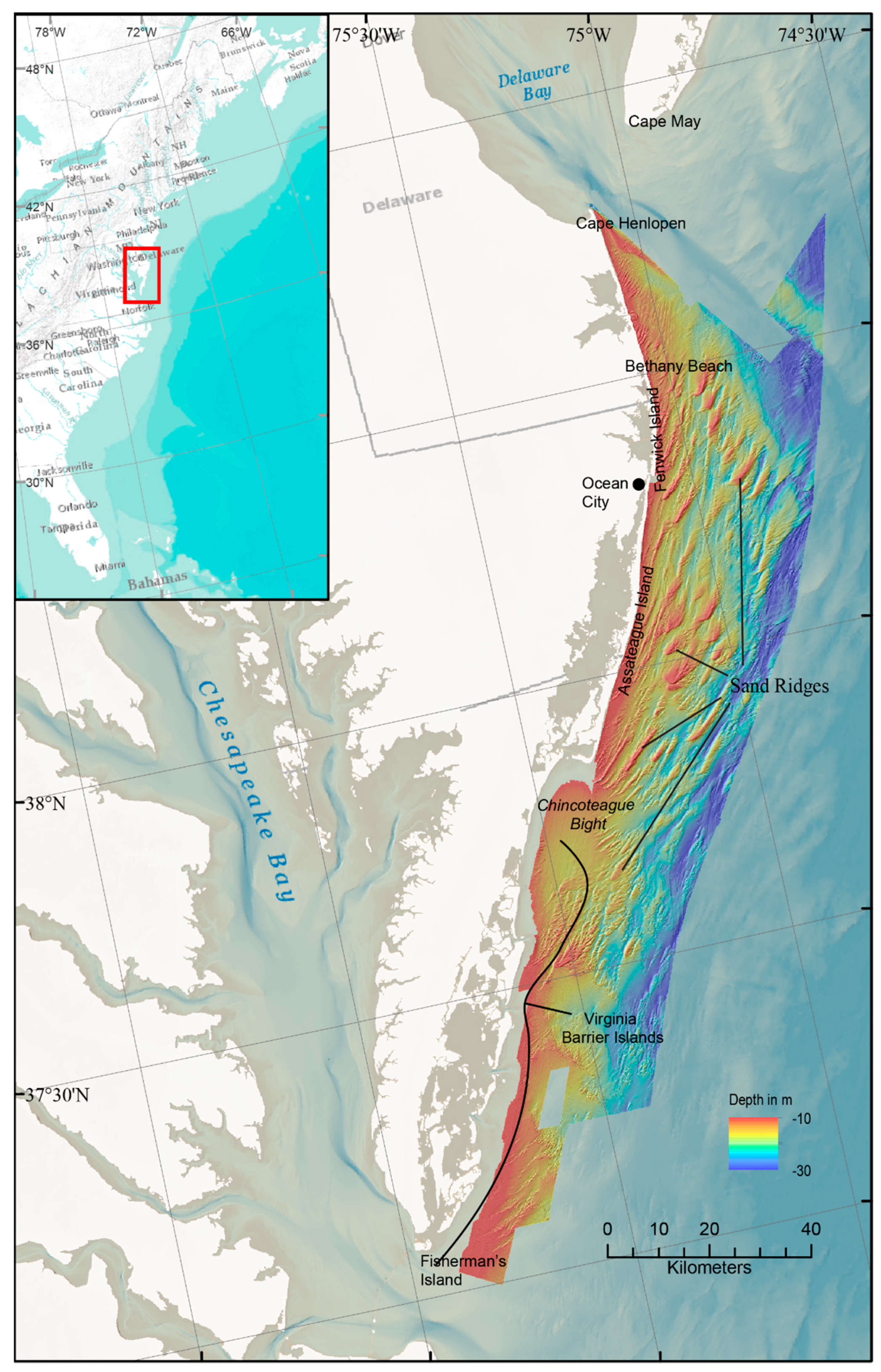
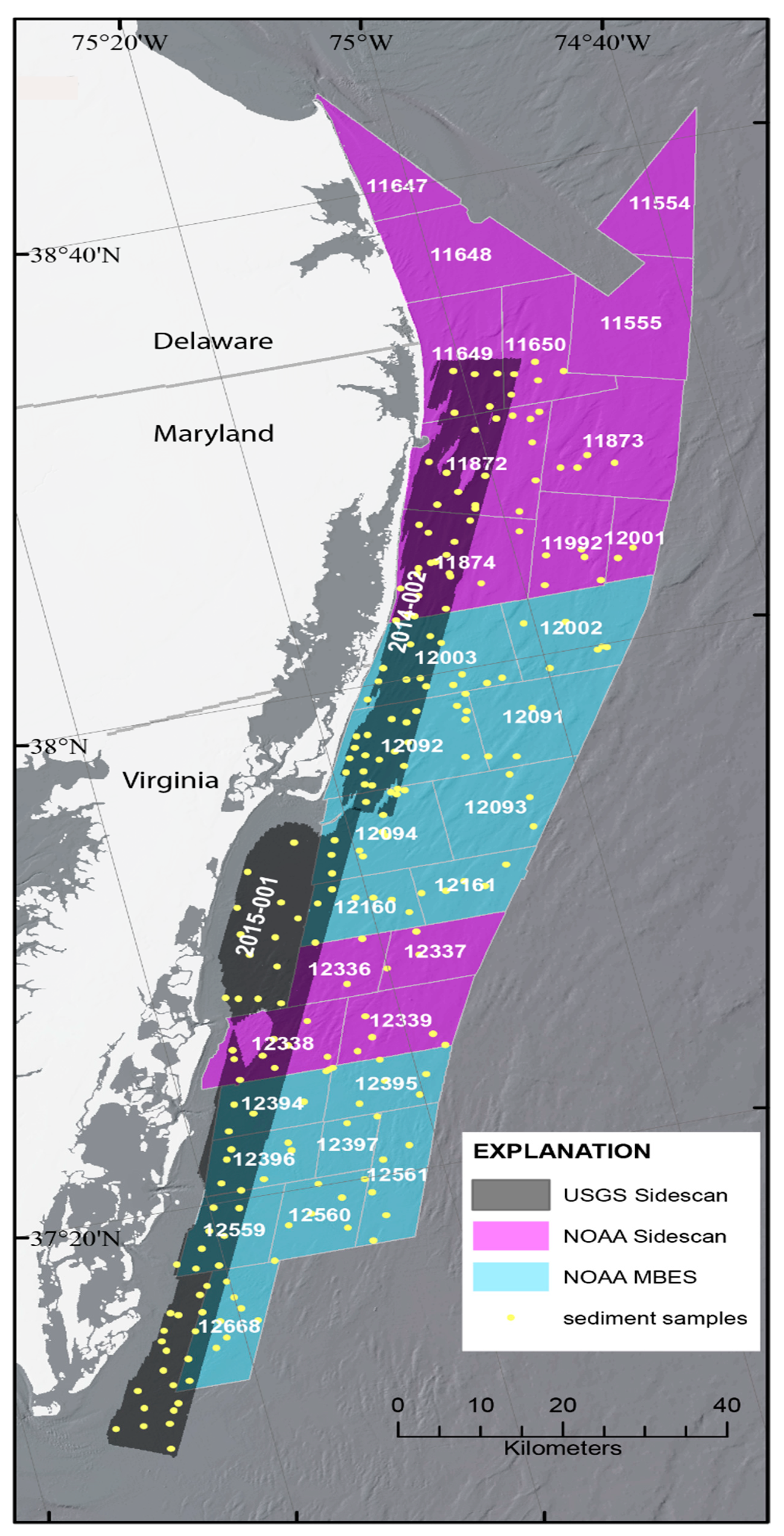

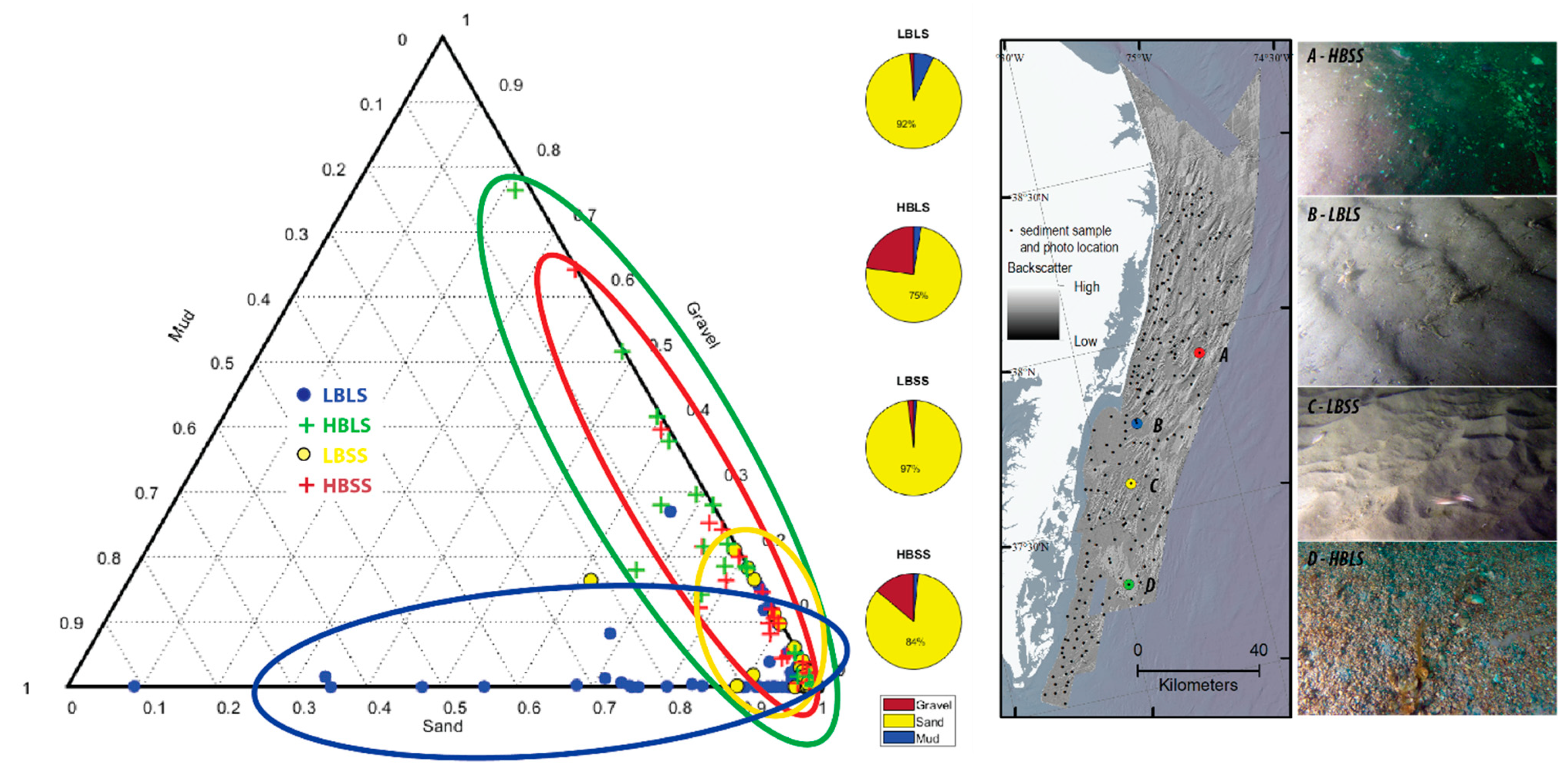
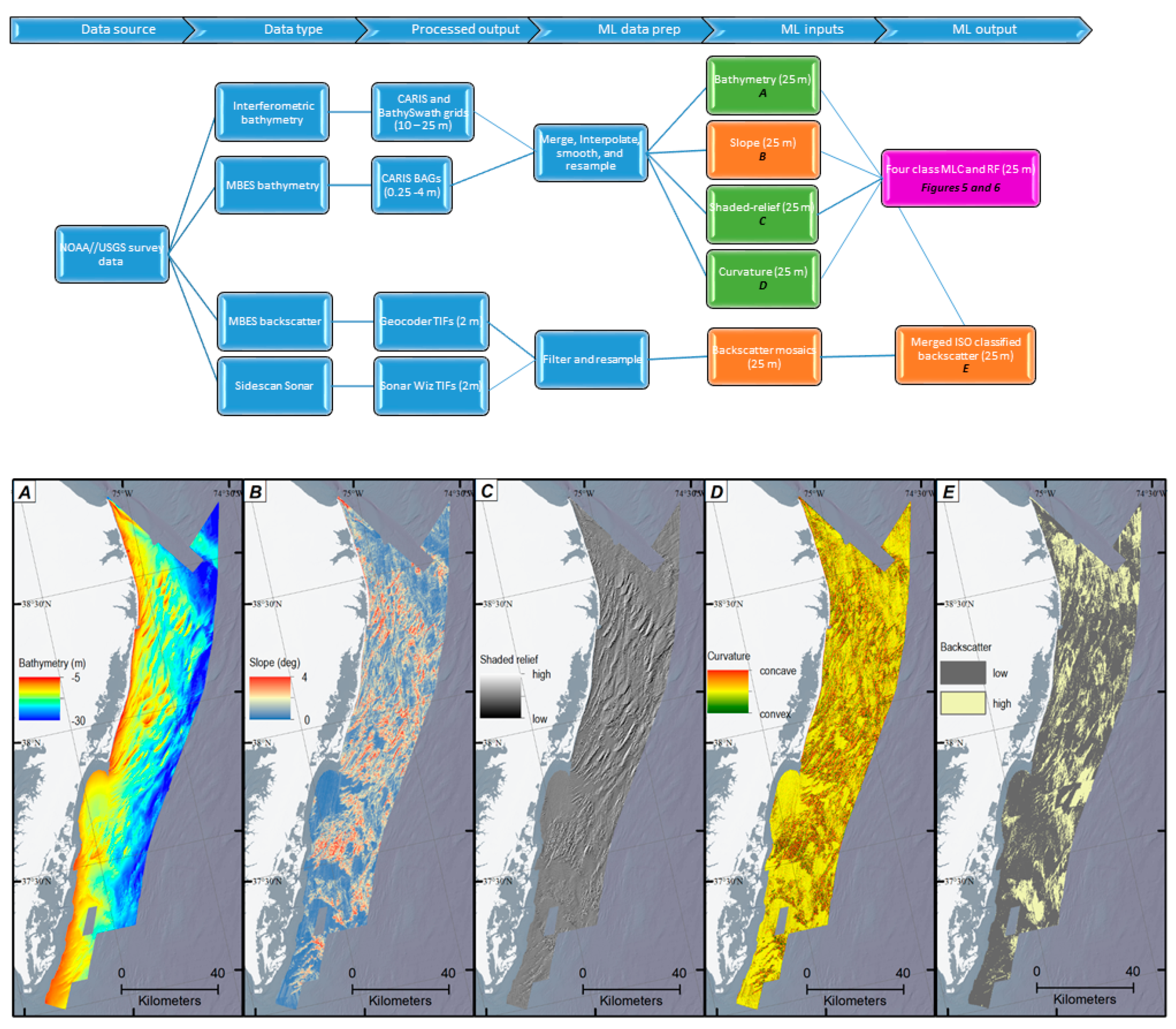
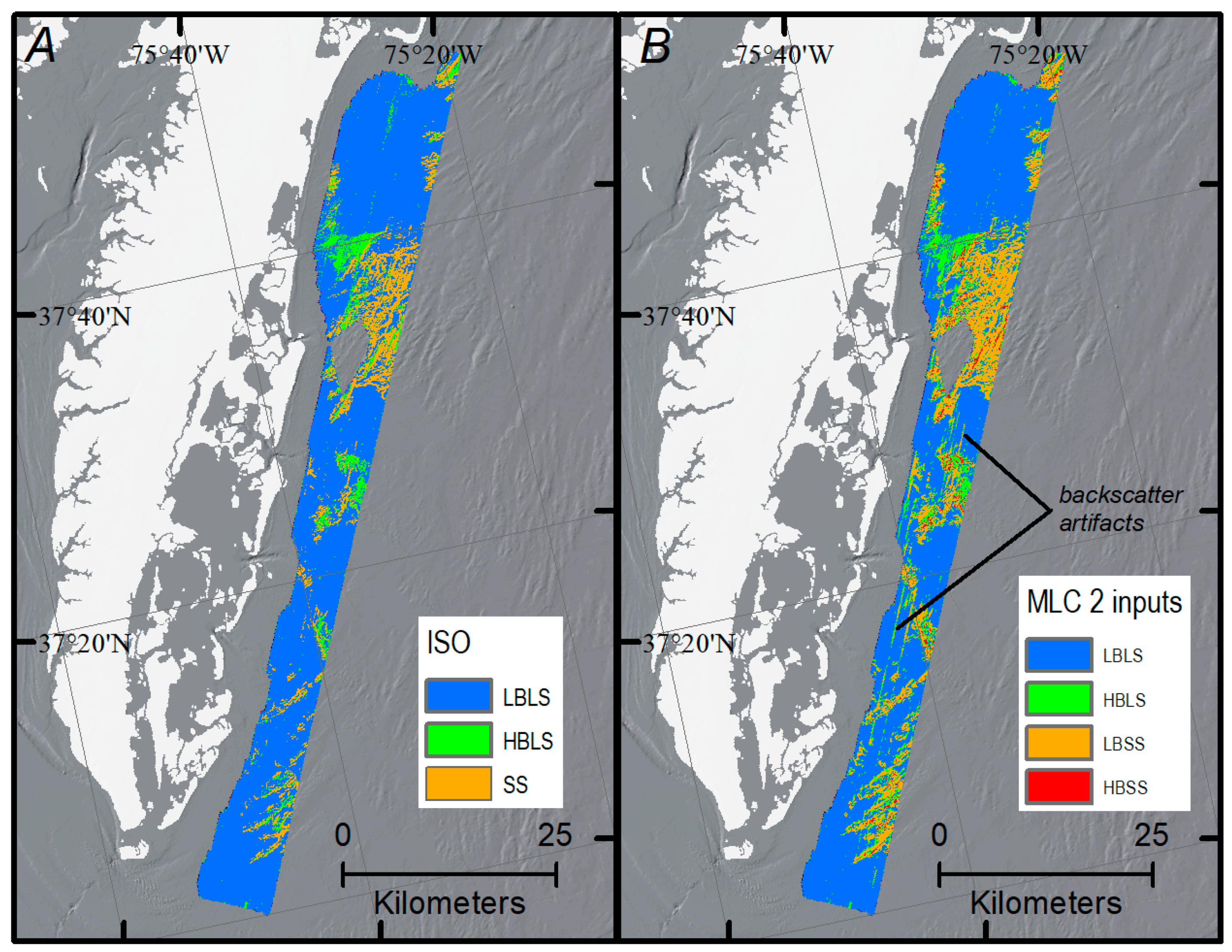
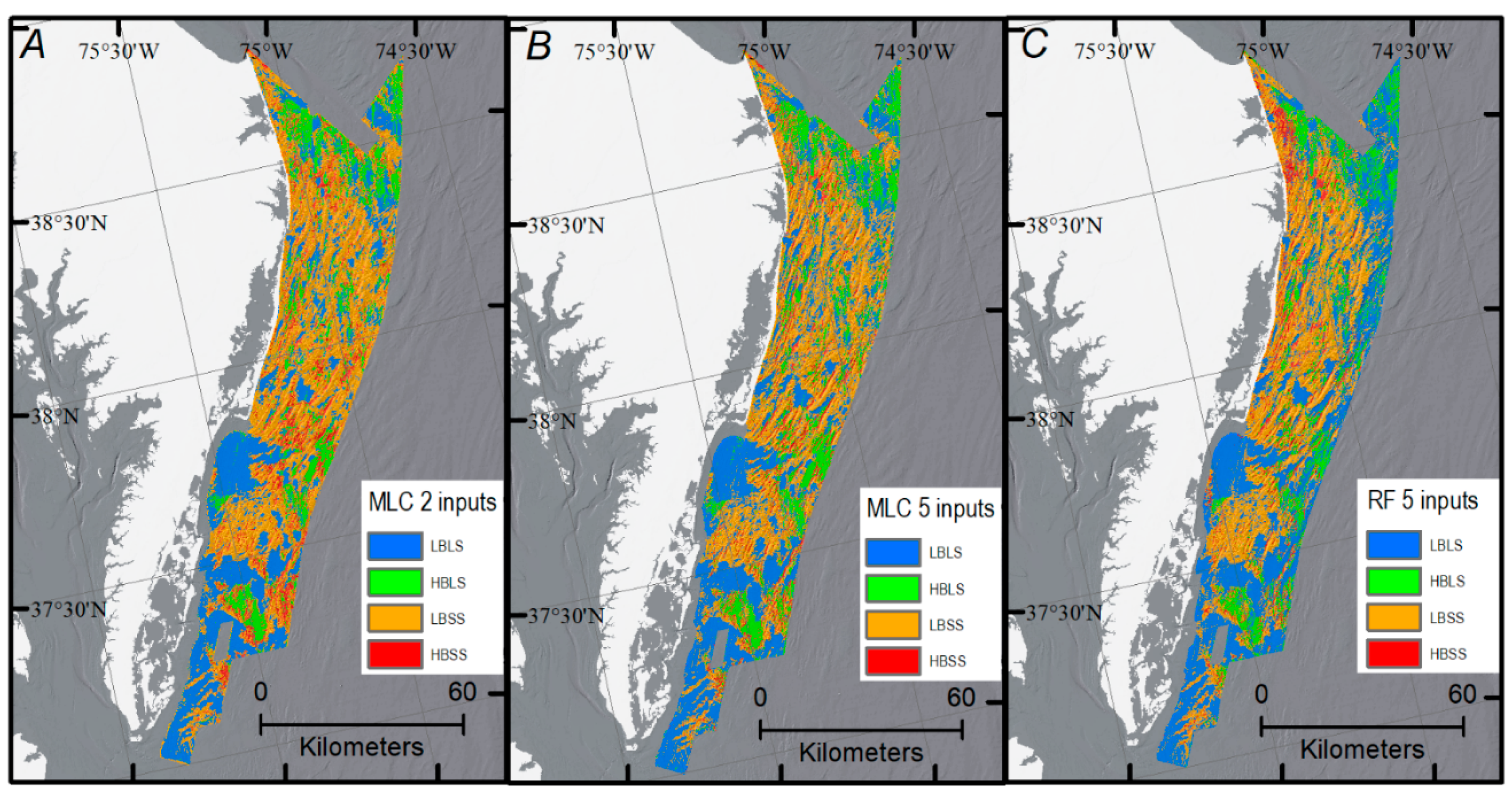
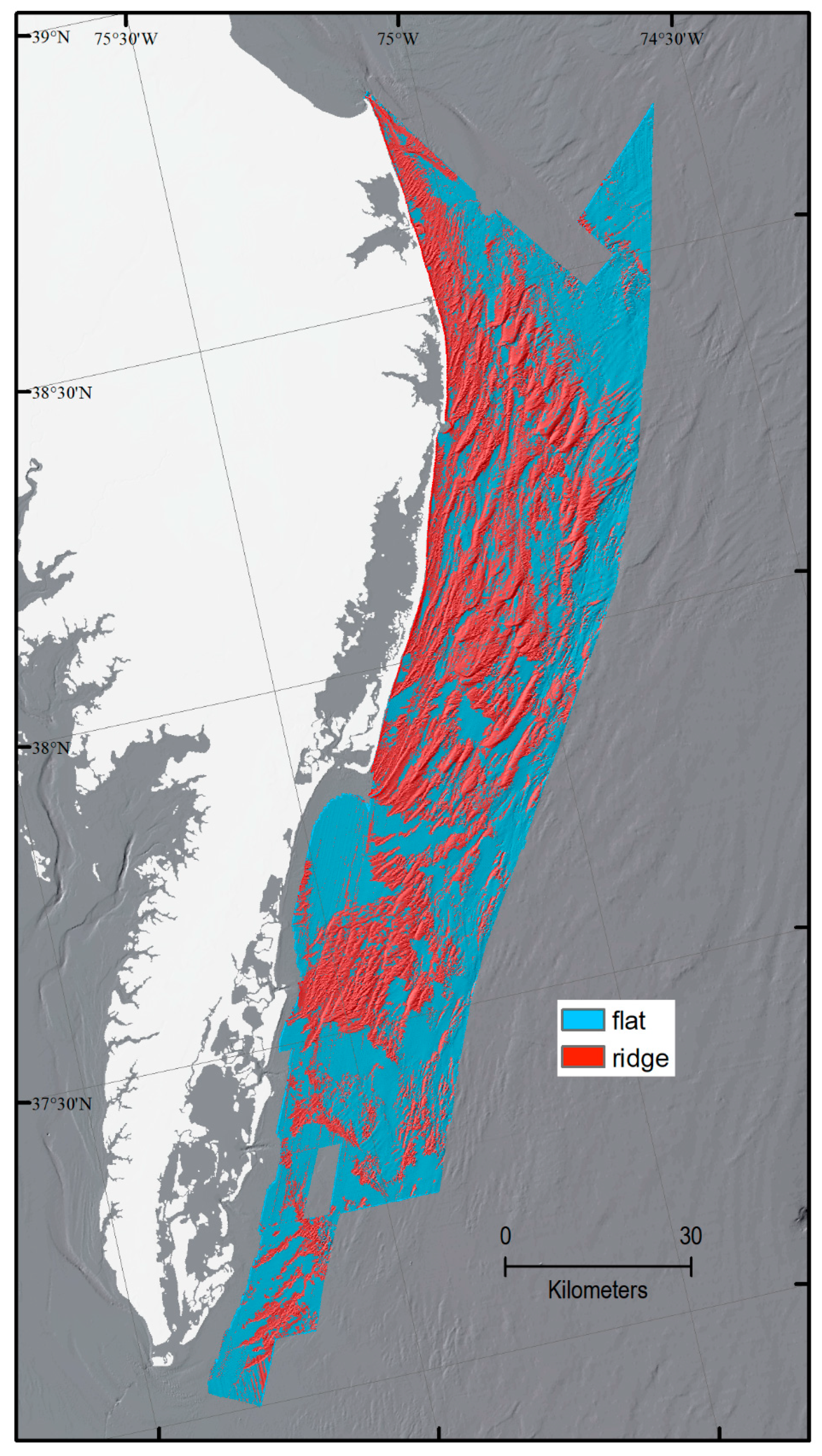
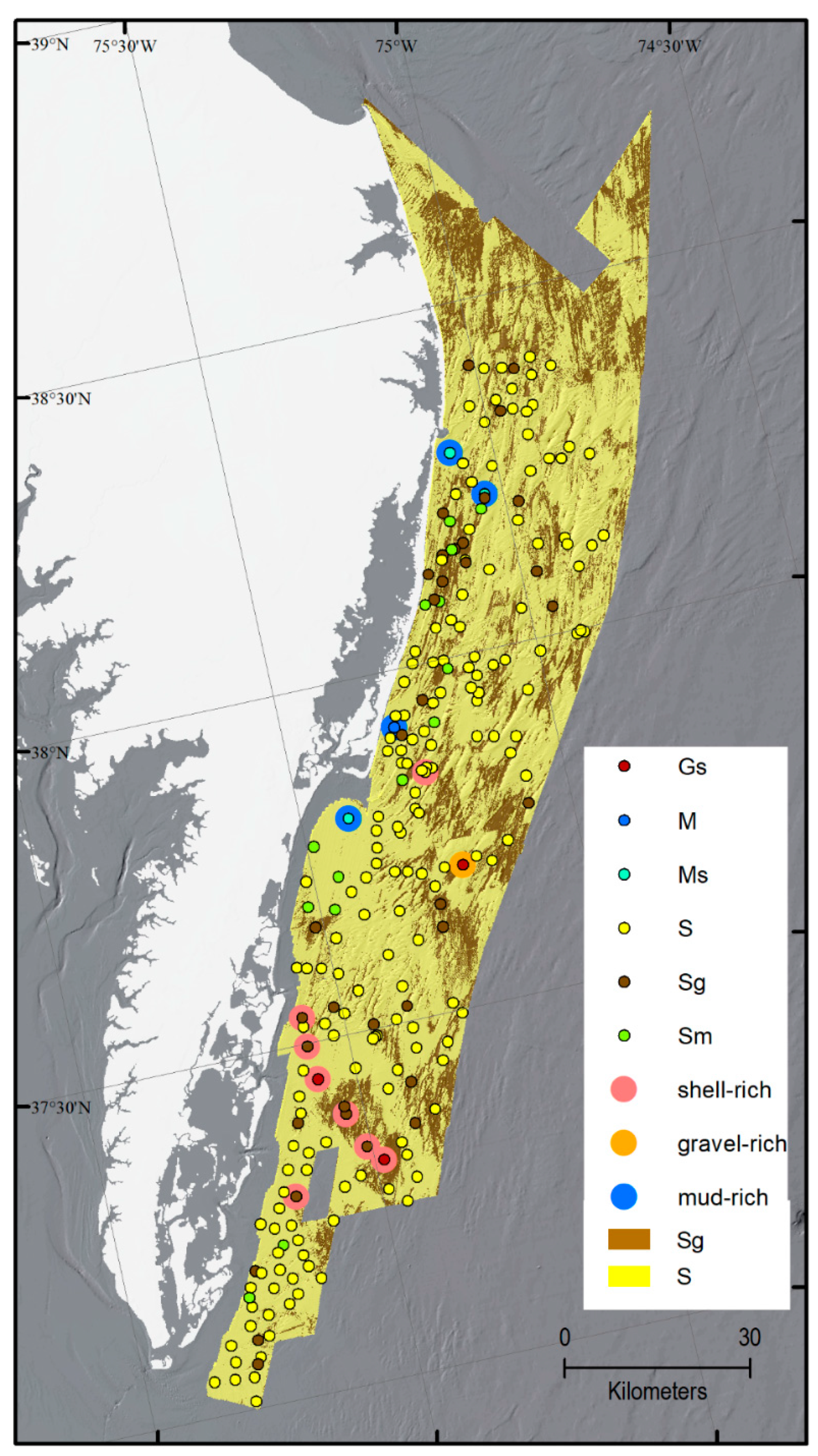
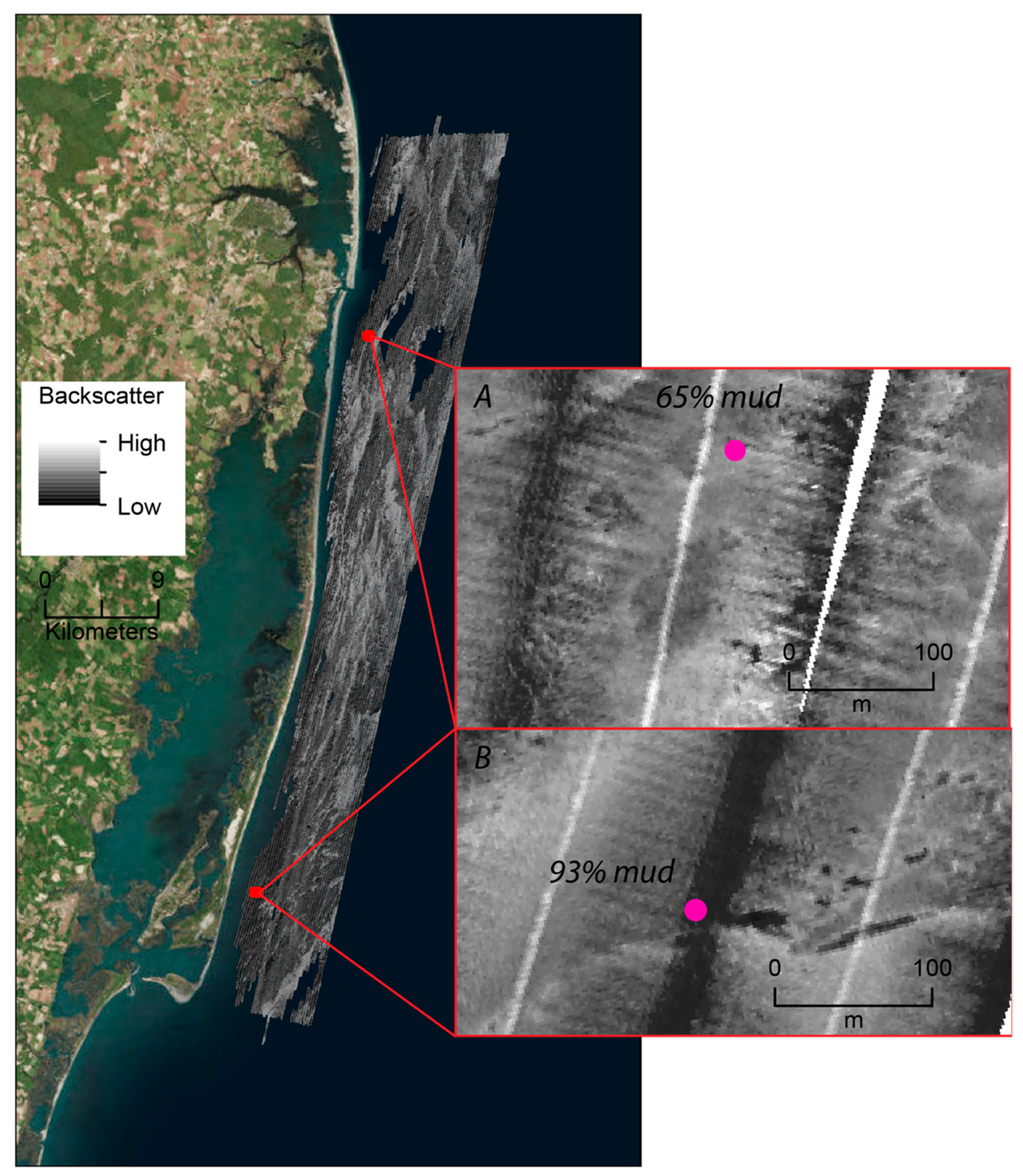
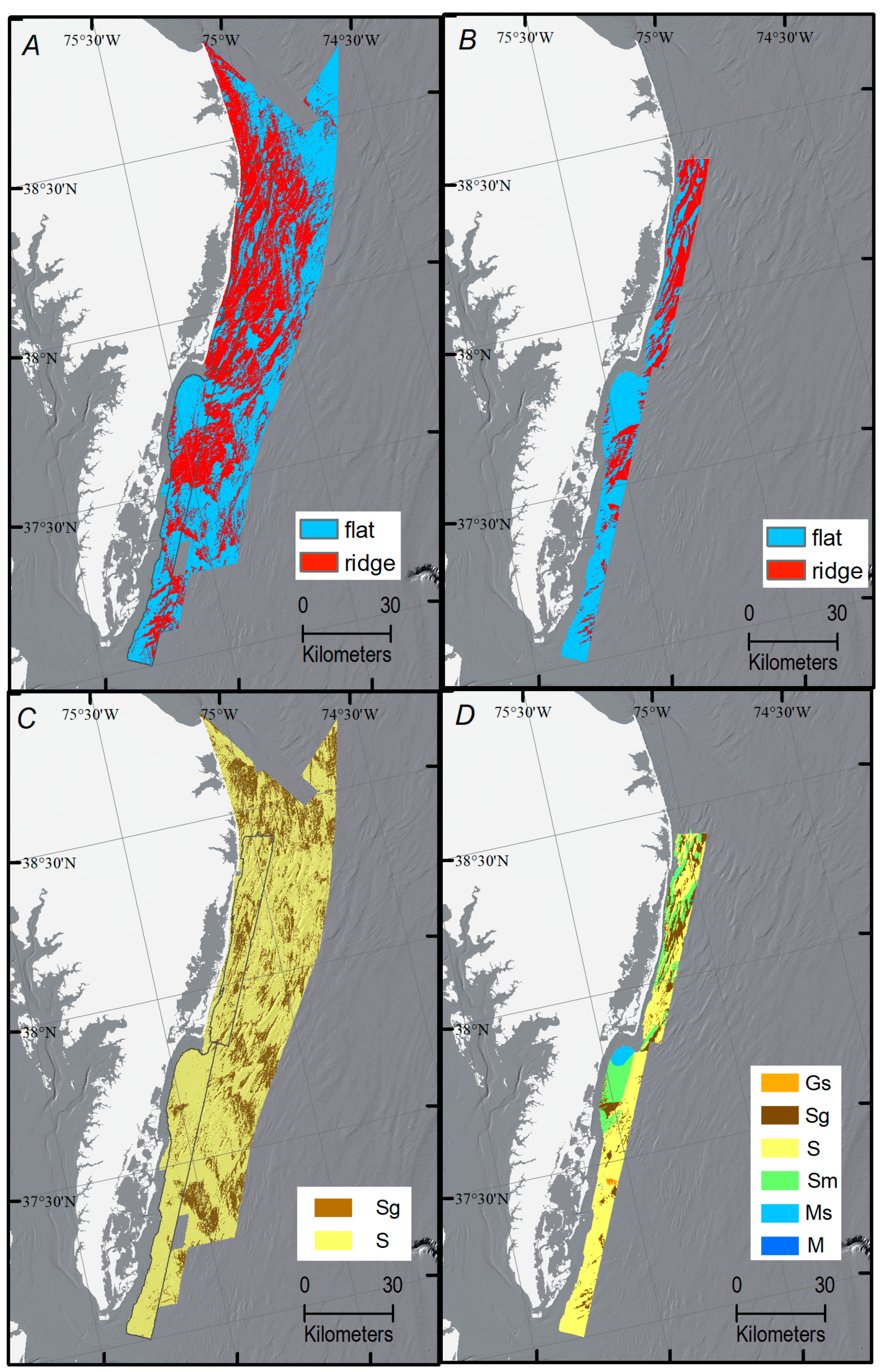
| Survey Number | Year Collected | Multibeam System | Sidescan Sonar System | Survey Area (km2) |
|---|---|---|---|---|
| H11554 | 2006 | Reson 8101 | Klein 3000 | 155 |
| H11555 | 2006 | Reson 8101 | Klein 3000 | 240 |
| H11647 | 2007 | Reson 8101 | Klein 3000 | 121 |
| H11648 | 2007 | Reson 8101 | Klein 3000 | 223 |
| H11649 | 2007 | Reson 8101 | Klein 3000 | 200 |
| H11650 | 2007 | Reson 8101 | Klein 3000 | 180 |
| H11872 | 2008 | Reson 8101 | Klein 3000 | 263 |
| H11873 | 2008 | Reson 8101 | Klein 3000 | 290 |
| H11874 | 2008 | Reson 8101 | Klein 3000 | 248 |
| H11992 | 2008 | Reson 8101 | Klein 3000 | 142 |
| H12001 | 2009 | Reson 7125 | Klein 3000 | 77 |
| H12002 | 2010 | Reson 7125 | Klein 3000 | 203 |
| H12003 | 2010 | Reson 7125 | Klein 3000 | 220 |
| H12091 | 2010 | Reson 7125 | Klein 3000 | 164 |
| H12092 | 2010 | Reson 7125 | Klein 3000 | 225 |
| H12093 | 2010 | Reson 7125 | Klein 3000 | 182 |
| H12094 | 2010 | Reson 7125 | Klein 3000 | 196 |
| H12160 | 2011 | Reson 7125 | Klein 3000 | 127 |
| H12161 | 2011 | Reson 7125 | Klein 3000 | 119 |
| H12336 | 2011 | Reson 7125 | Klein 3000 | 103 |
| H12337 | 2011 | Reson 7125 | Klein 3000 | 118 |
| H12338 | 2011 | Reson 7125 | Klein 3000 | 163 |
| H12339 | 2011 | Reson 7125 | Klein 3000 | 154 |
| H12394 | 2012 | Reson 7125 | Klein 3000 | 115 |
| H12395 | 2012 | Reson 7125 | Klein 3000 | 121 |
| H12396 | 2012 | Reson 7125 | Klein 3000 | 116 |
| H12397 | 2012 | Reson 7125 | Klein 3000 | 60 |
| H12559 | 2013 | Reson 7125 | Klein 3000 | 126 |
| H12560 | 2013 | Reson 7125 | Klein 3000 | 123 |
| H12561 | 2013 | Reson 7125 | Klein 3000 | 144 |
| H12668 | 2013 | Reson 7125 | Klein 3000 | 152 |
| 2014-002-FA | 2014 | SwathPlus | Klein 3000 | 535 |
| 2015-002-FA | 2015 | SwathPlus | Edgetech 4200 | 808 |
| Class | *Samples | Mean ɸ | % Gravel | % Sand | % Mud | **% Shell | Texture | Geomorphology |
|---|---|---|---|---|---|---|---|---|
| LBLS | 99/120 | 2.83 | 1.28 | 91.89 | 6.82 | 3.03 | S | Flat |
| HBLS | 14/19 | 0.51 | 22.89 | 74.64 | 2.55 | 28.36 | Sg | Flat |
| LBSS | 62/67 | 1.82 | 1.99 | 97.00 | 1.00 | 2.65 | S | Ridged |
| HBSS | 14/22 | 0.59 | 13.96 | 84.40 | 1.63 | 18.23 | Sg | Ridged |
| Location | Method | % Accuracy | Kappa |
|---|---|---|---|
| Test Area | ISO | 78.1 | 0.682 |
| MLC 2 inputs | 92.7 | 0.892 | |
| Whole Area | MLC 2 inputs | 73.0 | 0.603 |
| MLC 5 inputs | 76.0 | 0.645 | |
| RF 5 inputs | 77.5 | 0.667 |
© 2019 by the authors. Licensee MDPI, Basel, Switzerland. This article is an open access article distributed under the terms and conditions of the Creative Commons Attribution (CC BY) license (http://creativecommons.org/licenses/by/4.0/).
Share and Cite
Pendleton, E.A.; Sweeney, E.M.; Brothers, L.L. Optimizing an Inner-Continental Shelf Geologic Framework Investigation through Data Repurposing and Machine Learning. Geosciences 2019, 9, 231. https://doi.org/10.3390/geosciences9050231
Pendleton EA, Sweeney EM, Brothers LL. Optimizing an Inner-Continental Shelf Geologic Framework Investigation through Data Repurposing and Machine Learning. Geosciences. 2019; 9(5):231. https://doi.org/10.3390/geosciences9050231
Chicago/Turabian StylePendleton, Elizabeth A., Edward M. Sweeney, and Laura L. Brothers. 2019. "Optimizing an Inner-Continental Shelf Geologic Framework Investigation through Data Repurposing and Machine Learning" Geosciences 9, no. 5: 231. https://doi.org/10.3390/geosciences9050231
APA StylePendleton, E. A., Sweeney, E. M., & Brothers, L. L. (2019). Optimizing an Inner-Continental Shelf Geologic Framework Investigation through Data Repurposing and Machine Learning. Geosciences, 9(5), 231. https://doi.org/10.3390/geosciences9050231






